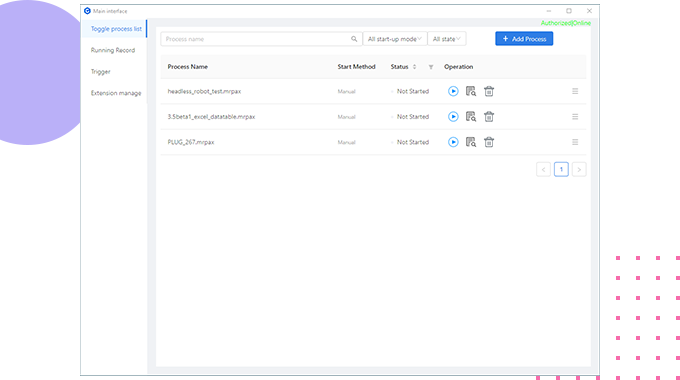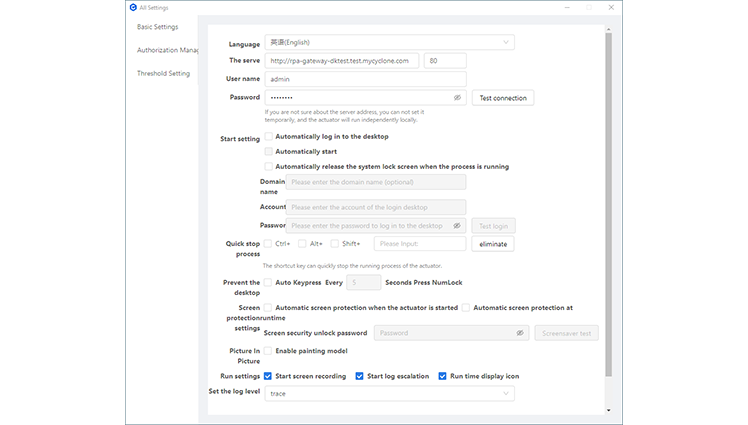 中文
中文

- Automatic Script Identification
- Support Multiple-Systems
- Support Screen-Locked
- Picture-In-Picture Mode
- High-density Mode
-
 Bank of Communications Financial Leasing
Bank of Communications Financial LeasingOne of the first 5 banking financial leasing companies under the banking category, approved by the China Banking and Insurance Regulatory Commission
-
 Huaxia Bank’s Branch
Huaxia Bank’s BranchHuaxia Bank, established in Beijing in October 1992, is now the fifth listed bank in China, ranking 65th in the world in terms of asset scale as of July 2020.
-
 Bank Of Liuzhou
Bank Of LiuzhouImproved business efficiency and optimized business functions: Cyclone RPA helps Bank of Liuzhou realize automated operation and maintenance
RPA Robotics
RPA Robotics has a lot of potential in the customer service business (RPA). A repeated back-office procedures consume approximately 80% of a customer care agent's time. The ability to better engage workers by eliminating the tedious administrative portions of their jobs is an appealing feature of RPA, especially for contact centers that are constantly fighting to prevent staff churn.
Robotic Process Automation RPA has significant commercial potential. Many firms have successfully used RPA technologies in other business sectors to support customer service positions. The RPA sector will be valued at $2.9 billion by 2021, with a growth of 20% per year in the healthcare space over the following five years.
What is Robotic Process Automation (RPA)?
Using a digital process to construct a virtual FTE (full-time equivalent) is known as robotic process automation. It can operate existing application software in the same way that a human can today, performing tasks such as transaction processing, data formatting, and file and folder movement.
The new approach involves monitoring and adjustments if the information flow changes, but it can’t eliminates the need for a person.
How RPA Robotics Works?
RPA is divided into three levels, each corresponding to a higher level of complexity. Robotic process automation starts with simple routines, but advanced process automation generally incorporates a built-in knowledge library that enables pattern identification in unstructured data. Cognitive automation combines AI, natural language processing, and self-learning to provide predictive analytics at its most complicated level.
Robotic Process Automation RPA Utilities
It's crucial to highlight that these advantages can only be realized if RPA is carefully deployed following a thorough examination of existing processes. If a corporation automates invoice approval, for example, it may neglect dozens of other approval processes within the company. RPA is not a "put it and forget it" activity; it takes constant top-down effort, coordinated resources, and time. Consider few points related to RPA Robotics
No Risk for Human Employment
RPA, despite its potential, is anxious about mistakes. Some predict it will eventually replace human occupations, while others believe cost savings will occur overnight.
RPA's capacity to cut labor costs and boost efficiency is, in fact, one of its main selling points. However, automation does not replace the need for human workers; instead, it raises the demand for more highly qualified workers.
Costs do not simply vanish from the equation. Before learning how automation may aid a company, it must first thoroughly document its procedures. That alone necessitates a substantial investment. There are also implementation costs to consider. After all of the groundwork has been established, savings opportunities become apparent.
As a result, Jepson recommends, "One risk is exaggerating the cost reductions that will eliminate a process. As a result, a new RPA program may be terminated or pushed aside too quickly.
RPA isn't only a technical endeavor, either. It's a combination of people, processes, and technology. As Jepson puts it, "They're all compatible. People support complex transactions, procedures are enhanced, and iterative transactions are handled by technology. The outcomes are only a win when all three operate together."
Controlling IT Spend
Unlike other traditional IT solutions, RPA enables businesses to automate at a fraction of the required price and time. RPA is also non-intrusive, leveraging current infrastructure without disrupting underlying systems that would be difficult and expensive to change.
RPA makes cost-effectiveness and compliance a consequence of automation rather than an operating cost. In the business world, RPA is the fastest expanding field. In diverse industries, numerous organizations and services must innovate.
You have the highest levels of accessibility and control when you run your own IT infrastructure. However, the costs soon mount – from the capital and operating expenditures to indirect business costs like downtime and reduced company agility and the personnel required to construct and maintain it all.
By outsourcing your workloads to a managed services provider, you can save money on capital and operating costs while also gaining access to cutting-edge technology. It enables you to focus your IT budget and resources on projects that directly benefit your company.
Protecting Business Data
Get a multi-layered security strategy that's laser-focused on your environment and capable of detecting, responding, and remediating threats to that environment. From reviewing your current environment to developing, operating, and monitoring your compliant cloud, our security experts will be with you.
Robotic Process Automation RPA Applications
RPA has a wide range of applications; however, some popular RPA tasks include:
· Using programs via logging in
· Completing forms
· Structured data extraction
· Combining data from many sources
· Information is copied and pasted.
· Database reading and writing
· Integrating with system APIs
· Opening attachments and emails
While the tasks that an RPA solution may perform are simple, the outcomes are pretty amazing. For example, recently deployed 50 RPA bots to automate billing, order shipment processing, and a variety of other operations for a major telecommunications company.
Within the provided set of functions, the bots achieved 90 percent automation, saving $6 million and 500,000 person-hours. Significantly, 50 people were reassigned to digital work that was more fascinating, fulfilling, and high-value.
Companies wanting to increase efficiency, production, and employee engagement across many industries can benefit from RPA. RPA allows contact center agents, back-office personnel, and other employees to focus on more complex transactions, as shown in the TELUS International example above, resulting in better engagement and satisfaction with their work.
There is also a significant advantage in terms of client satisfaction. According to NICE, 80% of corporate leaders believe RPA is critical to increasing customer service excellence since automating jobs leads to faster processing and fewer errors.
RPA can help firms scale up and down more successfully by adopting increasingly advanced IT infrastructures and seeking digital transformation. The RPA solution may also take on more complex jobs over time by incorporating machine-learning capabilities.
- Email us
-
(+65) 6978 5830
Working Hours 09:00 - 18:00











